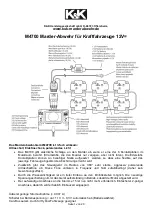
Switches & Relays
Switches are used in electrical circuits to control the passage of current. The most
common use is to open and close circuits between the battery and the various electric
devices in the system. Switches are rated according to the amount of amperage they can
handle. If sufficient amperage rated switch is not used in a circuit, the switch could
overload and cause damage.
Underhood fuse and relay panel
Some electrical components which require a large amount of current to operate use a
special switch called a relay. Since these circuits carry a large amount of current, the
thickness of the wire in the circuit is also greater. If this large wire were connected from the
load to the control switch, the switch would have to carry the high amperage load and the
fairing or dash would be twice as large to accommodate the increased size of the wiring
harness. To prevent these problems, a relay is used.
Relays are composed of a coil and a set of contacts. When the coil has a current passed
though it, a magnetic field is formed and this field causes the contacts to move together,
completing the circuit. Most relays are normally open, preventing current from passing
through the circuit, but they can take any electrical form depending on the job they are
intended to do. Relays can be considered "remote control switches." They allow a smaller
current to operate devices that require higher amperages. When a small current operates
the coil, a larger current is allowed to pass by the contacts. Some common circuits which
Summary of Contents for TrailBlazer
Page 1: ......
Page 26: ...Fig 3 Typical body and undervehicle maintenance locations Refer to chart for descriptions ...
Page 29: ......
Page 30: ......
Page 31: ......
Page 175: ...Spring free length check Valve spring squareness check ...
Page 192: ...Front of piston mark ...
Page 361: ...5 3L Engine Except Saab Underhood Fuse Block 2003 2005 Early Production ...
Page 469: ...Removing the outer band from the CV boot Removing the inner band from the CV boot ...
Page 470: ...Removing the CV boot from the joint housing Clean the CV joint housing prior to removing boot ...
Page 471: ...Removing the CV joint housing assembly Removing the CV joint ...
Page 472: ...Inspecting the CV joint housing Removing the CV joint outer snap ring ...
Page 473: ...Checking the CV joint snap ring for wear CV joint snap ring typical ...
Page 474: ...Removing the CV joint assembly Removing the CV joint inner snap ring ...
Page 475: ...Installing the CV joint assembly typical ...
Page 553: ...9 Torque the lug nuts to specification 10 Lower the vehicle ...
Page 556: ...Toe in Frame Misalignment Frame misalignment ...
Page 588: ...Bleeding caliper ...
Page 624: ...Manifold gauge set components Refrigerant recovery recycling station ...
Page 676: ...A C Specifications ...
Page 677: ......
















































